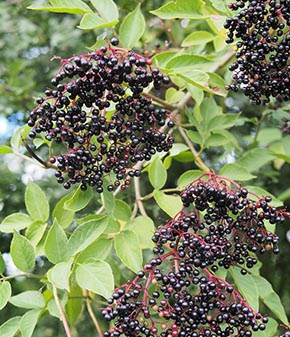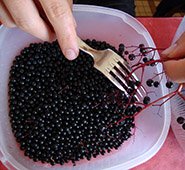Elderberry nutrition facts
Tiny, round elderberry is the storehouse of health-benefiting anthocyanin antioxidants. Early settlers of North America were well acquainted with the medicinal uses of elderflowers and berries long before the Spanish and other European explorers rediscovered their uses. These small round blue-purple berries have long been attributed to the longevity and wellness of indigenous natives around arctic regions of the Northern Hemisphere.
Scientific name: Sambucus nigra. L.
 |
| Elderberry in clusters. Courtesy- Tom Anderson. |
Elderberry is actually a small, deciduous tree that grows up to 7 to 10 meters tall. In cultivated orchards, their natural height is often allowed for only a few meters to help lateral spread and more fruit production.
The plant starts flowering during the second year of plantation and fruiting in its third year. Clusters of white or cream flowers cover the plant during early summer. Small, round, 8 to 10 mm size black or purple berries appear subsequently, which can be ready for harvesting by June, and the season lasts until September.
At maturity, elderberries in clusters hang upside down as the stem is often bent under the weight. A single cluster may hold hundreds of berries. Harvesting is done by handpicking.
European elderberries (S. nigra/ black elder) are intensely tart and rarely edible raw. American elder (S. canadensis) or "common elder" is relatively sweeter and tart. Only Blue or purple elders are edible, and other color variants are just avoided for their possible toxicity.
Both species require well-drained sandy, nitrogen-rich soil to flourish. Just as in blueberry shrub, it too prefers open sunny conditions and is intolerant of shade. In general, these berries can be ready for harvesting when they completely turn black or deep purple, and soft.
Health benefits of elderberry
100 g of fresh elderberries carry 73 calories. These tiny berries possess several unique health-benefiting plant nutrients such as pigment flavonoid antioxidants, anthocyanins, minerals, and vitamins that contribute immensely towards robust health and wellness.
The berries possess one of the highest antioxidant strengths among edible berries. ORAC value of 100 g fresh elderberry is 10775 TE (Trolox equivalents), whereas it is only 5562 TE for blueberry. Their antioxidant value, likewise in any other bushberries, also largely comes from polyphenolic flavonoid compounds such as flavonoids isorhamnetin, kaempferol, quercetin, etc. Together, these compounds help scavenge free oxygen radicals from the human body, and thereby, protect it from cancers, aging, degenerative diseases, and infections.
Fresh elderberries are excellent sources of vitamin C. 100 g carries 36 mg or 60% of the daily recommended intake levels of vitamin C.
Vitamin-C is one of the powerful water-soluble natural antioxidants that work against the viral flu. It also helps boost immunity, healing of wounds, fight against cancers, and is required by the body for the repair of tissues and cartilage.
Elderberries are also incredible sources of vitamin-A (provide 600 IU or 20% of RDA per 100 g), several times more than that of in other berries like blueberry (54 IU/100 g), chokeberry (214 IU/100 g), etc.
Vitamin A is an essential nutrient required for maintaining healthy mucosa and skin and is required for good eye health. Consumption of natural fruits rich in flavonoids and vitamin A may offer protection from lung and oral cavity cancers.
The berries also carry a relatively good amount of B-complex group of vitamins such as niacin, pyridoxine (18% RDI /100g), folates and pantothenic acid. These vitamins work as co-factors for those enzymes that help in the metabolism of carbohydrates, protein, and fats.
Furthermore, they contain a good amount of minerals like calcium, potassium, manganese, iron, and phosphorus. Potassium is an important component of cells and body fluids that helps control heart rate and blood pressure. The body uses manganese as a cofactor for the antioxidant enzyme, superoxide dismutase. Copper is essential for the production of red blood cells. Iron is required for red blood cell formation.
| Principle | Nutrient Value | Percent of RDA |
|---|---|---|
| Energy | 73 Kcal | 3.6% |
| Carbohydrates | 18.40 g | 14% |
| Protein | 0.66 g | 1% |
| Total Fat | 0.50 g | 2% |
| Cholesterol | 0 mg | 0% |
| Dietary Fiber | 7 g | 18% |
| Vitamins | ||
| Folates | 6 µg | 1.5% |
| Niacin | 0.500 mg | 3% |
| Pantothenic acid | 0.140 mg | 2.5% |
| Pyridoxine | 0.230 mg | 18% |
| Riboflavin | 0.060 mg | 4.5% |
| Vitamin A | 600 IU | 20% |
| Vitamin C | 36 mg | 60% |
| Electrolytes | ||
| Sodium | 6 mg | 0.5% |
| Potassium | 280 mg | 6% |
| Minerals | ||
| Calcium | 38 mg | 4% |
| Iron | 1.6 mg | 20% |
| Magnesium | 5 mg | 1.5% |
| Phosphorous | 39 mg | 5.5% |
| Zinc | 0.11 mg | 1% |
| Phyto-nutrients | ||
| Isorhamnetin | 5.4 mg | -- |
| Quercetin | 26.8 mg | -- |
Medicinal uses of elderberry
-
Only flower and ripe berries of elder plants are edible. Other plant parts including its bark, leaf, and root carry high levels of toxic alkaloids and should be avoided.
Berries and flowers have also found use in several traditional medicines around the world. Elderberry flower cordial has been a common household remedy for flu symptoms.
Its fruit extraction found its utility as anti-catarrhal (prevents cold), expectorant (anti-tussive), circulatory stimulant, and local anti-inflammatory actions.
Selection and storage
Elderberry season lasts from June until September in the US and Europe. Harvesting is done by handpicking. In general, the whole cluster of berries separated from the bush. The clusters can be kept in the refrigerator for extended utility. In the farmer's markets, you may find processed, stemmed ready-to-use elderberries put for sale.
In general, the berries intended to prepare the jelly and syrup are bought by potential customers or small-scale fruit processors. Unlike other berries and large-sized fruits, raw elderberries grab less attention because of their small size and intense tart flavor.
In the stores, look for fresh berries that are well-ripened, plump, intact, black/purple berries. Avoid red elderberries. Also, avoid very soft or shriveled, over-handled, bruised berries and those with signs of mold and old stock.
Preparation and serving tips

|
| Stemming of elderberry using a fork. Photo-blesseurope. |
Elderberries have a bitter-tasting stem, firmly attaching at the top end as in cherries which must be separated before use. To make this work easy, the whole cluster of berries is kept inside the freezer to harden them which are then separated from the panicle by stripping or shaking off. The other great way is to comb the panicle using a fork. Thus prepared berries are then either re-frozen for later use or thawed for quick processing.
Elderberries carry a sweet yet extremely tart flavor and therefore, are preferred only after cooking.
Here are some serving tips:
Elderberry flower cordial is a favorite summer season refreshing drink across Europe.
The berries can be employed in the preparation of jam, jelly, syrup, and concentrates.
Cold elderberry soup is a traditional summer season drink in Germany.
Dry elderberries found their use in cakes, pies, summer pudding, crumbles, muffins, etc.
Elderflower/dried berry tea is a special drink across Europe.
Safety profile
Elderberries of blue/purple and black varieties of S. Canadensis and S. nigra only can be edible. Red elders (Sambucus racemosa) are quite poisonous and therefore avoided. Elderberry leaves roots, and stems carry cyanidin alkaloid compounds which when consumed may produce nausea, vomiting, and neurological symptoms. (Medical disclaimer).
≻≻-Back to Fruits from Elderberry. Visit here for an impressive list of all varieties of fruits with complete illustrations of their nutrition facts and health benefits.
≻≻-Back to Home page.
Further reading and Resources:
Refer Stanford School of Medicine Cancer information Page- Nutrition to Reduce Cancer Risk (Link opens new window).
Elderberry as a medicinal plant- Pudue University. (Link opens in new window).
Plant guide USDA-pdf.